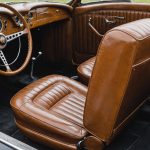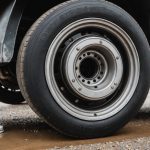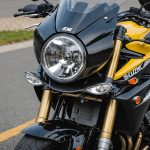Selecting the Perfect Paint for Your DIY Vintage British Motorcycle Respray: A Comprehensive Guide
When it comes to restoring a vintage British motorcycle, one of the most critical and rewarding steps is the paint job. The right paint can transform your old bike into a stunning piece of art that not only looks good but also protects the metal from corrosion. Here’s a detailed guide to help you select and apply the perfect paint for your DIY vintage British motorcycle respray.
Understanding the History and Significance of British Racing Green
Before diving into the technical aspects of painting, it’s interesting to understand the historical context of the colors you might choose, particularly British Racing Green (BRG). This iconic color has a rich history that dates back to the early 20th century.
Topic to read : Discover the Safest Upholstery Cleaning Methods for Vintage Leather Interiors in British Cars
British Racing Green originated in 1902 when British cars first competed in international racing events. Since the colors of the British national flag were already taken by other countries, the British opted for a green shade, initially known as Shamrock Green, as a sign of respect to their Irish hosts during the 1903 Gordon Bennett Cup[4].
Over the years, BRG has evolved, with various shades being used, but the deep, rich green we know today became prominent in the 1929 Monaco Grand Prix. This color has since become synonymous with British motorsport and is still celebrated today.
Also to see : Unlocking Enhanced Security: A Step-by-Step Guide to Installing a Dashcam in Your British Vehicle
Choosing the Right Paint for Your Motorcycle
Types of Paints Available
When selecting paint for your vintage motorcycle, you have several options to consider:
- Original Manufacturer Shades: If you want to maintain the original look of your motorcycle, you can opt for paints that match the manufacturer’s original colors. Companies like Stardust Colors specialize in producing paints that match the color codes of various motorcycle brands[2].
- Custom and Effect Paints: For those looking to give their bike a unique touch, custom and effect paints offer a wide range of possibilities. These can include metallic, pearl, or even glow-in-the-dark finishes.
- High Heat Engine Paints: If you’re painting engine components, you’ll need paints specifically formulated to withstand high temperatures and corrosion. VHT high heat engine paint is a good example of this type of paint[1].
Key Characteristics to Consider
Here are some key characteristics to look for when choosing the right paint for your project:
- Durability: The paint should be able to withstand the elements and the wear and tear of regular use.
- Adhesion: Good adhesion is crucial to ensure the paint doesn’t flake off easily.
- Chemical Resistance: The paint should be resistant to chemicals and additives that might come into contact with the bike.
- Color Accuracy: If you’re going for an original look, color accuracy is paramount.
Preparing Your Motorcycle for Painting
Before you start painting, it’s essential to prepare your motorcycle thoroughly. Here are some steps to follow:
Cleaning the Surface
- Remove Old Paint and Rust: Use a wire brush or sandpaper to remove any old paint, rust, or debris from the surface.
- Clean with Solvents: Use a solvent to clean the surface, ensuring it’s free from grease, oil, or any other contaminants.
- Sand the Surface: Sand the surface to create a smooth, even finish.
Applying Primer
- Choose the Right Primer: Select a primer that is compatible with your paint. For example, VHT high heat engine primer is ideal for engine components[1].
- Apply Evenly: Use a spray gun or brush to apply the primer evenly, making sure to cover all areas.
Applying the Paint
Tools You’ll Need
Here are some essential tools you’ll need for the painting process:
- Spray Gun: HVLP (High Volume, Low Pressure) spray guns are highly recommended for a smooth, even finish.
- Air Compressor: Ensure your air compressor is capable of providing the necessary air pressure for your spray gun.
- Masking Tape: Use masking tape to protect areas you don’t want to paint.
- Paint Booth or Workspace: If possible, use a paint booth or a well-ventilated workspace to minimize dust and debris.
Steps for Spray Painting
Here’s a step-by-step guide to spray painting your motorcycle:
- Set Up Your Workspace:
- Ensure your workspace is clean, dry, and well-ventilated.
- Use a drop cloth or old sheets to protect the floor.
- Prepare Your Paint:
- Shake the paint can thoroughly before use.
- If using a spray gun, make sure it’s properly connected to your air compressor.
- Apply Thin Coats:
- Start with a thin coat to avoid drips and unevenness.
- Allow each coat to dry completely before applying the next one.
- Use Masking Tape:
- Apply masking tape to areas you don’t want to paint, such as logos or trim.
- Finish with a Clear Coat:
- Once you’ve applied the final coat of paint, finish with a clear coat to protect the paint and give it a glossy finish.
Tips and Tricks for a Professional Finish
Maintaining the Right Air Pressure
- HVLP Systems: Use HVLP systems for a smooth finish. These systems operate at lower pressures, reducing overspray and ensuring a more even coat.
- Adjust Air Pressure: Make sure to adjust the air pressure according to the manufacturer’s instructions for your spray gun.
Avoiding Common Mistakes
Here are some common mistakes to avoid:
- Inadequate Surface Preparation: Ensure the surface is clean and smooth before painting.
- Insufficient Drying Time: Allow each coat to dry completely before applying the next one.
- Incorrect Air Pressure: Adjust the air pressure to the recommended level to avoid unevenness and overspray.
Practical Insights and Actionable Advice
Color Matching
If you’re aiming for an original look, color matching is crucial. Here’s how you can ensure you get the right color:
- Consult Original Manuals: Refer to the original manuals or color codes provided by the manufacturer.
- Use Color Matching Services: Companies like Stardust Colors offer color matching services where they produce paints based on your motorcycle’s original color code[2].
Using the Right Kit
When choosing a paint kit, make sure it includes everything you need for the job. Here’s what a comprehensive kit should include:
| Component | Description |
|---|---|
| Paint | The actual paint in the desired color |
| Primer | A compatible primer to ensure good adhesion |
| Clear Coat | A clear coat to protect the paint and give it a glossy finish |
| Thinner | A thinner to adjust the paint consistency |
| Masking Tape | To protect areas you don’t want to paint |
| Spray Gun | An HVLP spray gun for a smooth finish |
| Air Compressor | An air compressor capable of providing the necessary air pressure |
Quotes from Experts
- “The key to a good paint job is in the preparation. Make sure the surface is clean and smooth before you start painting,” says John Smith, a veteran motorcycle restorer.
- “Using the right tools, such as HVLP spray guns, can make a huge difference in the finish. It’s worth investing in good quality equipment,” advises Jane Doe, a professional painter.
Painting your vintage British motorcycle is a rewarding project that requires careful planning and execution. By understanding the historical significance of colors like British Racing Green, choosing the right paint, preparing your motorcycle thoroughly, and using the right tools and techniques, you can achieve a professional finish that will make your bike stand out.
Remember, patience and attention to detail are key. Take your time, follow the steps outlined here, and you’ll be on your way to creating a stunning piece of art that not only looks good but also protects your motorcycle for years to come.
Final Checklist
Here’s a final checklist to ensure you have everything you need for your project:
- Paint and Primer: Compatible paint and primer for your motorcycle.
- Spray Gun and Air Compressor: HVLP spray gun and an air compressor.
- Masking Tape: To protect areas you don’t want to paint.
- Clear Coat: To protect the paint and give it a glossy finish.
- Thinner: To adjust the paint consistency.
- Drop Cloth or Old Sheets: To protect the floor.
- Well-Ventilated Workspace: To minimize dust and debris.
By following this guide, you’ll be well on your way to giving your vintage British motorcycle a paint job that’s both beautiful and durable. Happy painting











